Gdynia-Pomeranian 作者: 来源: 发布时间:2021-03-08
Ⅰ. Population and Area
Population (31 December 2019)
City 246,348 Increase (12th)
Area
City 135 km2 (52 sq mi)
Website http://www.gdynia.pl
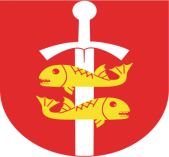
Ⅱ.Natural Geography (environment and resources)
Gdynia: a city in northern Poland, at the Bay of Gdansk, of an area of 135 km2, one forming – along with the adjacent Sopot and Gdansk – a metropolitan organism commonly referred to as the Tri-City.
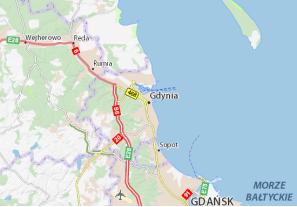
Take a bird’s eye view of Gdynia. Out of all the hills and rises in Gdynia, Góra Donas (Mount Donas) is the highest one (205.7 m above sea level), a tele-communicational tower and a 26.5 m high overlook tower on the top of it. One can reach the place by following the marks of the yellow trail and starting from the woods near Wolności Street (the Działki Leśne neighbourhood) or setting off from the bus terminus at Miętowa Street (the Dąbrowa neighbourhood). There is a similar object at Spółdzielcza Street. On one of the hills, near the historical frontier between Poland and the Free City of Gdansk, a tower fitted with an overlook terrace was built in 2007: the terrace offers a view of the Bay of Gdansk, the panoramas of Gdynia, Sopot and Gdansk. One can reach the place from Wielkopolska Street by taking a turn to Spokojna Street and continuing along a field path leading to Spółdzielcza Street. Both terraces may be climbed free of cost over the period from 1st April to 31st October, 08.00-18.00 hrs, weather permitting, naturally.
Nature under protection. The administrative boundaries of Gdynia encompass a lot of parks and nature reserves, this including part of the Trójmiejski Park Krajobrazowy (Tri-City Landscape Park) covering two sanctuaries and several nature monuments. The park was created in 1979. The Kępa Redłowska reserve is one of the most beautiful places on Polish coast. Created in 1938 (this rendering it one of the oldest reserves in Poland), the reserve occupies an area of 118.16 ha between the Orłowo neighbourhood and Kamienna Góra (Stone Mountain). In the Kępa Redłowska reserve, a special protection is given to the natural beech forest and Swedish ash trees. The sea buckthorn is its most characteristic plant. The reserve is one of the best places where one can see the formation of cliffs. About 60 m high, the Klif Redłowski (Redłowo Cliff) is probably the most widely known cliff in Poland. One can enjoy a marvellous view of the Bay of Gdansk and of the Gdynia itself from it. Quite different are the attractions to be admired during an excursion to the sylvan-florist Kacze Łęgi reserve (8.97 ha) in the Kacza River dell that was created in 1983. It comprises a segment of the brook with its tiny tributary and a well preserved part of the water woods with impressive tree stands and numerous monument trees. Protected here are the remnants of the original flora of the river dells (elm tree water woods) in the form which is typical for the flora of the bottoms of small river dells. It was created in the same year. The Cisowa reserve protects fragments of beech woods and ash-alder water forests. In the reserve’s area of 24.76 ha there also grows a big quantity of protected and rare species of plants.
Enclave in the heart of Gdynia. In the area of Kamienna Góra – a hillside area with detached houses situated in the very heart of Gdynia – is a park offering an overlook from which one can admire the city centre, its port and the Bay of Gdansk. In 1994, a 25 m high metal cross was erected on the top of the rise: it is floodlit at night, visible from Gdansk and the Hel Peninsula in good weather. In the park, besides beeches, oaks, maples, hornbeams, rowan and cherry trees, there are also decoration strains of trees and bushes like for instance ash-leave maples, taxodiums, thujas, yews, and junipers. A big part of that fragment of Kamienna Góra are squares, greens and lawns planted with colourful flower compositions. In the summer time, Kamienna Góra becomes a place where concerts of promenade music are held. All this makes the rise one of the nicest parts of Gdynia and the favourite walking grounds of both the locals and tourists. In November 2011, the park of Kamienna Góra was given the name of Lech and Maria Kaczyńskis. Kamienna Góra is also a complex of villas the majority of which were built already before World War II. Both the urban complex of the neighbourhood and the individual houses of the place have been entered in the register of historical buildings.
The neighbourhood of Gdynia can be very attractive as a tourist destination. From the south, it is surrounded by the area of Tricity Landscape Park, and deeper into the interior the Kashubian Lakeland spreads out.
Transport
Port of Gdynia
Pesa Atribo SA133 of the Tricity Fast Urban Railways (SKM) departing from Gdynia
Port of Gdynia
Main article: Port of Gdynia
In 2007, 364,202 passengers, 17,025,000 tons of cargo and 614,373 TEU containers passed through the port. Regular car ferry service operates between Gdynia and Karlskrona, Sweden.
Airport
The conurbation's main airport, Gdańsk Lech Wałęsa Airport, lays approximately 25 kilometres (16 mi) south-west of central Gdynia, and has connections to approximately 55 destinations. It is the third largest airport in Poland. A second General Aviation terminal was scheduled to be opened by May 2012, which will increase the airport's capacity to 5mln passengers per year.
Another local airport, (Gdynia-Kosakowo Airport) is situated partly in the village of Kosakowo, just to the north of the city, and partly in Gdynia. This has been a military airport since the World War II, but it has been decided in 2006 that the airport will be used to serve civilians. Work was well in progress and was due to be ready for 2012 when the project collapsed following a February 2014 EU decision regarding Gdynia city funding as constituting unfair competition to Gdańsk airport. In March 2014, the airport management company filed for bankruptcy, this being formally announced in May that year. The fate of some PLN 100 million of public funds from Gdynia remain unaccounted for with documents not being released, despite repeated requests for such from residents to the city president, Wojciech Szczurek.
Road transport
Trasa Kwiatkowskiego links Port of Gdynia and the city with Obwodnica Trójmiejska, and therefore A1 motorway. National road 6 connects Tricity with Słupsk, Koszalin and Szczecin agglomeration.
Railways
The principal station in Gdynia is Gdynia Główna railway station, and Gdynia has five other railway stations. Local services are provided by the 'Fast Urban Railway,' Szybka Kolej Miejska (Tricity) operating frequent trains covering the Tricity area including Gdańsk, Sopot and Gdynia. Long distance trains from Warsaw via Gdańsk terminate at Gdynia, and there are direct trains to Szczecin, Poznań, Katowice, Lublin and other major cities. In 2011-2015 the Warsaw-Gdańsk-Gdynia route is undergoing a major upgrading costing $3 billion, partly funded by the European Investment Bank, including track replacement, realignment of curves and relocation of sections of track to allow speeds up to 200 km/h (124 mph), modernization of stations, and installation of the most modern ETCS signalling system, which is to be completed in June 2015. In December 2014 new Alstom Pendolino high-speed trains were put into service between Gdynia, Warsaw and Kraków reducing rail travel times to Gdynia by 2 hours.
Ⅲ.Economy
Gdynia is an important port city which is located in the northern part of Poland and the southern part of the Baltic Sea. With more than 30 terminals there, the total length of the terminal line is more than 9,100 meters. Among them, the largest berth of seagoing boats with a draught of 8.5 meters or more is 7,439 meters. Gdynia is one of the youngest and most dynamic cities in Poland. Gdynia, a small fishing village in 1922, has developed into a now deep-sea fishing and shipbuilding center. Now Gdynia is also home to the Polish navy headquarters, which is known as “Window to the World,” in Poland. The city of Gdynia is located on the coast of the Baltic Sea. With a population of about 300,000, Gdynia is part of the Maritime Province in the northern of Poland. And it is far away from Warsaw about 170 miles.
In Gdynia, Poland economy, Manufacturing Assembly Worker is on the top list of highest earners, earning an average gross salary of PLN 400,000. Finance Manager and Plant Manager follow, earning PLN 345,000 and PLN 220,000, respectively.
Summary about cost of living in Gdynia:
Cost of living index in Gdynia is 55.45% lower than in New York.
Rent in Gdynia is, on average, 81.24% lower than in New York.
Cost of living rank 347th out of 552 cities in the world.
Gdynia has a cost of living index of 44.55.
Notable companies that have their headquarters or regional offices in Gdynia:
PROKOM SA – the largest Polish I.T. company
C. Hartwig Gdynia SA – one of the largest Polish freight forwarders
Sony Pictures – finance center
Thomson Reuters – business data provider
Vistal – bridge constructions, offshore and shipbuilding markets; partially located on old Stocznia Gdynia terrains
Nauta – ship repair yard; partially located on old Stocznia Gdynia terrains
Crist – shipbuilding, offshore constructions, steel structures, sea engineering, civil engineering; located on old Stocznia Gdynia terrains
Former:
Stocznia Gdynia – former largest Polish shipyard, now under bankruptcy procedures
Nordea – banks, sold and consolidated with PKO bank
Ⅳ.Industrial Characteristics
Port cargo handling of Gdynia is the top priority in Poland. In addition, there are bulk goods such as grain, coal, ore, etc. Nowadays, The annual throughput of the port is about 15 million tons, ranking third in Poland. And there are more than 30 regular liner routes to the world. The main economic industries of Gdynia are related to the ocean: port industry, shipbuilding industry, navigation training, deep-sea fishery and so on. 40% of Gdynia residents are engaged in the jobs related to the marine industry and the port industry. Gdynia's other economic industries are organic electricity, chemicals, minerals, paper, construction, light industry and food processing.
Key Project
1. Deepening the Port of Gdynia in Poland brings economic, environmental benefits
The port of Gdynia in northern Poland is being deepened and its quays modernised in a major construction scheme backed by the EU’s Cohesion Fund. The modifications allow the port to accommodate bigger ships and handle more cargo. The improvements should increase traffic safety while helping the port’s users to reduce transport costs and cut emissions.
Deepening the Port of Gdynia in Poland brings economic, environmental benefits-Projects - Regional Policy - European Commission https://ec.europa.eu/regional_policy/en/projects/poland/deepening-the-port-of-gdynia-in-poland-brings-economic-environmental-benefits
2. Red Road to the Port of Gdynia – Investmet co-financed from Multiannual Programme for the Central Transportation Port
Marek Gróbarczyk, Minister of Maritime Economy and Inland Navigation and Marcin Horała, Government Plenipotentiary for the Central Transport Port, signed an agreement on improving access to the Port of Gdynia in the presence of Polish Prime Minister Mateusz Morawiecki. Preparatory works for the construction of the so-called Red Road in Gdynia will be financed from the CTP Multiannual Programme for 2020-2023.
Red Road to the Port of Gdynia – Investmet co-financed from Multiannual Programme for the Central Transportation Port https://www.port.gdynia.pl/en/events/news/1637-red-road-to-the-port-of-gdynia-investmet-co-financed-from-multiannual-programme-for-the-central-transportation-port
3. The Port of Gdynia is expanding its hinterland
The increase in the transshipment in seaports is increasingly related to the potential of intermodal transport, which in the upcoming years will become the main branch of freight transport both in Poland and in Europe. The growing volume of transshipments makes it necessary to build logistics facilities and modernize railway lines. The idea of a "dry port" - transshipment terminal, which will be a land gate for the Tri-City ports in Poland - will be very innovative.
Port of Gdynia https://www.port.gdynia.pl/en/
Ⅴ.Attrations and Cityscape
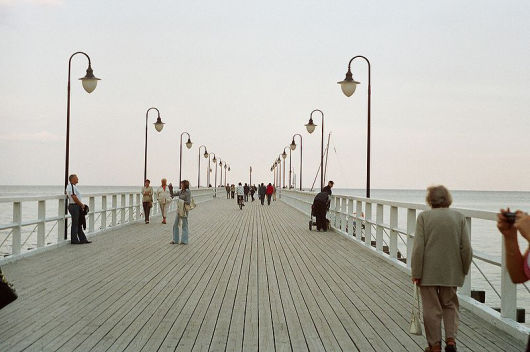
Gdynia's main boardwalk
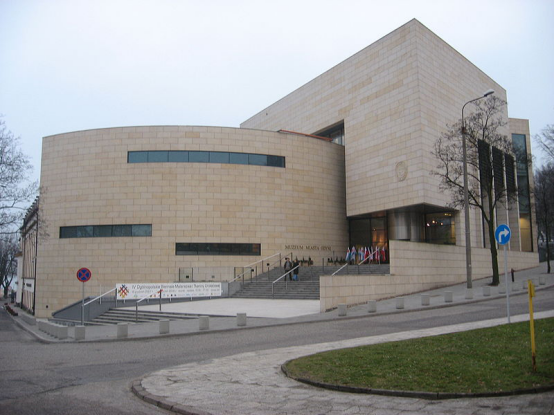
City Museum in Gdynia
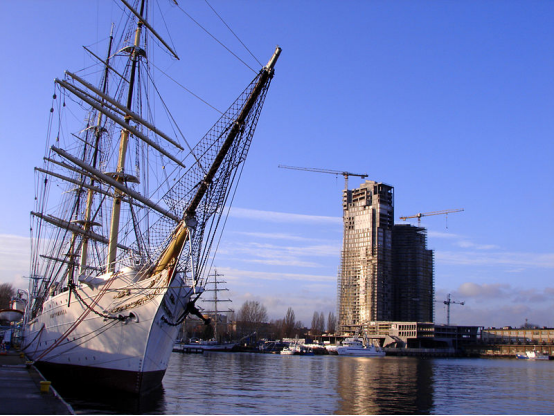
View from Kosciuszko Square; Dar Pomorza on the left, Sea Towers on the right
Gdynia is one of the youngest Polish cities, which is reflected in its appearance and atmosphere. Its bustling centre and harbour are visited mainly in the summer, due to its maritime location and the long sandy beaches. Throughout the entire year, it plays the role of one of Poland’s major seaports and a major shipbuilding area.
Apart from the shipyard, Gdynia is a thriving centre of business, boasting the status of the most prosperous Polish city. Its close vicinity to two other towns, Gdansk and Sopot, which together form an urban agglomeration, helps to develop commercial activity.
As far as sightseeing is concerned, Gdynia is especially suited to admirers of 1920s and ‘30s architecture, as you can hardly find anything older there. The great attractions of the city are two ships-museums, the frigate Dar Pomorza (The Gift of Pomerania) and the destroyer Blyskawica (The Lightning), while the Oceanographic Museum and Aquarium allow visitors to deepen their knowledge of the sea.
For a place to relax, it is best to visit the nearby Kepa Redlowska natural reserve, or the beautiful environs of Orlowo. Gdynia itself has an active nightlife and excellent restaurants. Moreover, the city hosts two important cultural events, the Polish Feature Film Festival and Summer Jazz Days.
Gdynia is a relatively modern city.[11][failed verification] Its architecture includes the 13th century St. Michael the Archangel's Church in Oksywie, the oldest building in Gdynia, and the 17th century neo-Gothic manor house located on Folwarczna Street in Orłowo. The city also holds many examples of early 20th-century architecture, especially monumentalism and early functionalism, and modernism. A good example of modernism is PLO building situated at 10 Lutego Street.
The surrounding hills and the coastline attract many nature lovers. A leisure pier and a cliff-like coastline in Kępa Redłowska, as well as the surrounding Nature Reserve, are also popular locations. In the harbour, there are two anchored museum ships, the destroyer ORP Błyskawica and the tall ship frigate Dar Pomorza. A 1.5-kilometre (0.93 mi)-long promenade leads from the marina in the city center, to the beach in Redłowo.
Most of Gdynia can be seen from Kamienna Góra (54 metres (177 feet) asl) or the viewing point near Chwaszczyno. There are also two viewing towers, one at Góra Donas, the other at Kolibki.
Ⅵ.History and Culture
Historically and culturally part of Kashubia in Eastern Pomerania, Gdynia for centuries remained a small farming and fishing village. At the beginning of the 20th-century, Gdynia attracted visitors as a seaside resort town, and began to build tourism. The local population increased in response to the change in the economy.
After Poland regained its independence in 1918, the government decided to construct a Polish seaport in Gdynia, between the Free City of Danzig (a semi-autonomous city-state) and German Pomerania, making Gdynia a primary economic hub. In 1926 Gdynia was granted city rights, after which it enjoyed a rapid demographic and architectural development.
This was interrupted by the outbreak of World War II, during which the newly built port and shipyard were completely destroyed. The population of the city suffered heavy losses, as most of the inhabitants were evicted and expelled by the German occupiers. The locals were either displaced to other regions of occupied Poland or sent to German Nazi concentration camps throughout Europe.
After the war, Gdynia was settled with the former inhabitants of Warsaw, which also suffered major destruction, and lost cities, such as Lviv and Vilnius in the Eastern Borderlands. The city was gradually regenerating, with its shipyard being rebuilt and expanded. In December 1970 the shipyard workers' protest against an increase in government-established prices was violently repressed by government forces. This greatly contributed to the rise of the Solidarity movement in nearby Gdańsk.
Today the port of Gdynia is a regular stopover on the crusing itinerary of large, luxury passenger ships. A new ferry terminal with a civil airport are under development. The city has won numerous awards for its safety, infrastructure, quality of life, and a rich variety of tourist attractions. In 2013 Gdynia was ranked by readers of The News as Poland's best city to live in, and topped the national rankings in the category of "general quality of life"
Ⅶ.Other Information
There are two major harbor area in Gdynia.In the North Harbor area, there are so many ports, such as, the Port of Yugoslavia, the port of Romania, the port of India, the port of Rotterdam, the port of Poland, the port of Finland, etc. And in the in the East Harbor area, the dock of France, the ferry terminal of Netherlands, the Roll-on-ship dock of Denmark, the dock of Sweden, etc.
Ⅷ.Contact Information
- Mayor Wojciech Szczurek
- ul. 10 Lutego 2481-364 Gdynia
- +48 58 622 37 66
-
